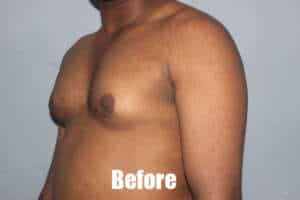Before/After
Long-Term Body shape Correction
Gynecomastia is an increase in the amount of breast gland tissue in boys or men, caused by an imbalance of the hormones estrogen and testosterone. Gynecomastia can affect one or both breasts, sometimes unevenly.
Newborns, boys going through puberty and older men may develop gynecomastia as a result of normal changes in hormone levels, though other causes also exist.
Generally, gynecomastia isn’t a serious problem, but it can be tough to cope with the condition. Men and boys with gynecomastia sometimes have pain in their breasts and may feel embarrassed.
Gynecomastia may go away on its own. If it persists, medication or surgery may help.
Symptoms
Signs and symptoms of gynecomastia include:
- Swollen breast tissue
- Breast tenderness
When to See your doctor if you have:
- Swelling
- Pain or tenderness
- Nipple discharge in one or both breasts
Frequently Asked Questions
How do I know if I’m a candidate for gynecomastia surgery?
Generally,non-physiological gynacomastia resolves spontaneously in 1 years duration, the gynacomastia which persists for more than 1 years with or without treatment needs surgical correction. Dr. Peter and his staff will conduct a thorough examination and collect all information regarding your medical history. Dr. Peter will also want to know all your expectations and answer any questions you might have regarding the procedure and post-op care. That’s why it is better to consult a plastic surgeon.
What kind of scars will I have?
Gynecomastia results in minimal scarring, with most scars being hidden under the armpit. If your male breast reduction is combined with a lift, you will have scars around your areola that are hidden in the pigment changes of your skin.
Are there complications with male breast reduction surgery?
The most common complication is accumulation of blood in the wound. This is not a serious complication and many times, the blood can be drained with a needle. Occasionally, we have to open the wound to drain. Areolar loss (loss of sensation in the areola) may also occur.
What should I expect after the surgery?
Since you will be coming out of anesthesia, you will need someone to stay with you for 24 hours after the surgery. You should expect some bruising and swelling on the chest. You will wear a compression vest for 6 weeks and keep your activity light. Most patients take one week off of work, although you are free to go back to work after the drain tubes are removed.









